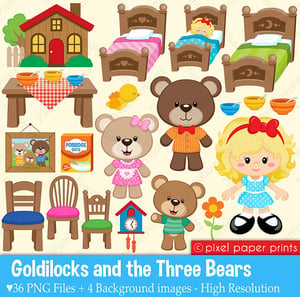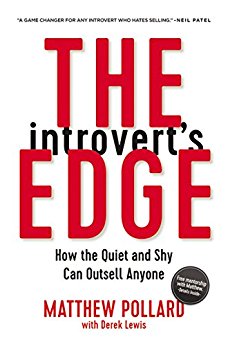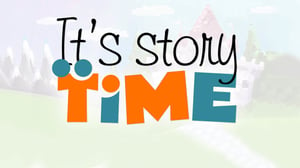There’s a method to deliver your message more effectively to your employees, the people you supervise, even your prospects, and customers.
The message you deliver will not only be understood, it will be remembered.
Here are three items I’d like you to remember: Food, Chair, Bed.
If I ask you a year later, can you to repeat this list in order?
You probably have difficulty remember this blog, let alone the list.
 However, I bet right now you can tell me the story of Goldilocks and the three bears!
However, I bet right now you can tell me the story of Goldilocks and the three bears!
What did she do?
She ate their food, broke their chairs, and slept in their beds.
You have no difficulty remembering this same sequence as the list I started with, and yet you probably have not heard the story of Goldilocks and the three bears for many years!
That’s the power of a story
 If you are an introvert hoping to build a career in sales, The Introvert's Edge: How the Quiet and Shy Can Outsell Anyone, by Matthew Pollard and Derek Lewis is a must read for you.
If you are an introvert hoping to build a career in sales, The Introvert's Edge: How the Quiet and Shy Can Outsell Anyone, by Matthew Pollard and Derek Lewis is a must read for you.
If you’re a leader, it a powerful technique, to get your message remembered!
Matthew Pollard is an introvert. He struggled in sales, learning the skills set required to be remarkable at sales through hard knocks and experience. Pollard wrote The Introvert's Edge to help introverts sell. His book contains a hidden skill to help you lead your team to remember your leadership messages.
Science of Story Telling
Why does storytelling work?
Researchers in Spain discovered when participants read words that evoke a sense of smell (like perfume and coffee), different areas of the brain light up versus when the same people read non-sensory words (e.g., chair and key).
In other words, the more sensory the words, the more the brain engages.
There’s evidence we use the same parts of the brain to understand stories as we do to understand other people, from Psychologist Raymond Mar’s 2011 neuroscience study. His research reveals, stories help the receiver empathize with the storyteller and better understand their “who,” “what,” and “why.”
Dr. Paul Zak, a colleague of the late management guru Peter Drucker, studied the effect of oxytocin (a natural chemical that helps us empathize with other people) and storytelling show a direct correlation between stories and trust. He’s even coined the term neuromanagement to describe how managers can use stories to create a workplace culture of trust.
Tell A Story
You have personal experiences you can relate. You have stories from your previous employers, stories from interacting with customers.
To get started, you need only one good story.
Matthew Pollard believes it’s easier for introverts to tell stories than it is to sell benefits.
Benefits are a list of things you say that you believe the prospect wants to hear. They lack heart and soul. It feels unnatural and inauthentic to list them. Remembering your benefits in order is hard to do, especially in the middle of a sales meeting with your prospect.
Professor Jennifer Aaker at Stanford discovered that people are twenty-two times more likely to recall information delivered in the form of a story than listed as just plain facts.
Dr. Uri Hasson at Princeton uncovered evidence of what’s called “neural coupling”: When we listen to a story, our brains begin to synchronize with the storyteller’s; the same parts of our brains become active at the same time. Telling a story is as close to telepathy as you can get
.png?width=300&height=225&name=Core%20Values%20(Handful%20of%20Rules).png) Practice Your Story – Core Values
Practice Your Story – Core Values
Don’t just tell your story off the cuff. It’s your livelihood we’re dealing, whether it’s persuading the people who work for you, or your customers/prospects.
Write your story down and practice, practice, practice.
Find one or two stories to convey the value of what you sell, and tell them well. We often tell our Gazelles customers to do this every year with your Core Values. Many of my customers celebrate their Core Values by giving an award to one of their employees who exemplify the company’s Core Values.
When you do this, you not only have a story to tell, you have a person who is the story.
You may feel, “But I don’t want to sound like a robot!” (That’s the reason you practice!)
You may think sales scripts are robotic because you have heard telemarketers and salespeople sound scripted.
What separates good actors from bad, just like the good salespeople from bad, is their diligence to script mastery. Make the script your own.
To achieve this, just like a professional actor, you must start by learning the words of the script to 100 percent accuracy.
You can’t sit there and read from your script. That’s why telemarketers always sound robotic.
A good salesperson memorizes their script, practices it over and over again until it sounds natural.
When I was in sales, Tom Hopkins How to Master the Art of Selling was the bible for anyone who wanted to learn how to sell.
Hopkins technique to help salespeople close a prospect who is indecisive is called the Ben Franklin Close.
The video here explains the technique.
In my sales career, I became very good at using the Ben Franklin close. I still use it today with many of my customers when they have difficulty making a decision. I’m not closing them, I’m helping them to decide. The reason I got good at the Ben Franklin close is because I used it for all of my difficult decisions.
It wasn’t just for closing a sale, it was part of my decision-making tool kit I used personally when facing a difficult decision.
When your story is about you, your experiences, and you have real-life wisdom from using it, it becomes natural for you to tell it.
Growth demands Strategic Discipline.
Positioning Systems helps your business grow through the Four Decisions: People, Strategy, Execution, Cash.
Each of the Four Decisions Produces a specific outcome. In our coaching process, we tell stories to illustrate the examples of the Four Decisions and each of the exercises and resources we use with our customers.
|
DECISION |
RESULT/OUTCOME |
|
PEOPLE |
|
|
STRATEGY |
|
|
EXECUTION |
|
|
CASH |
|
If you’re business is failing to achieve industry leading results in any of these areas, that Decision should be your One Thing.
Positioning Systems helps mid-sized ($5M - $250M) business Scale-UP. We align your business to focus on Your One Thing! To achieve growth, you need to evolve in today’s rapidly changing economic environment. Are you avoiding a conversation with yourself on how to can successfully grow your business? Contact dwick@positioningsystems.com to Scale Up your business! Take our Four Decisions Needs Assessment to discover how your business measures against other Scaled Up companies. We’ll contact you.
 NEXT BLOG – Create Your Story in Four Steps
NEXT BLOG – Create Your Story in Four Steps
Don’t know where to start, the create a story, your story? Matthew Pollard breaks it down into four steps: Problem, Analysis & Implementation, Outcome, and Moral. We share the method to these four steps in our next blog.






.jpeg?width=150&height=135&name=Hand%20with%20marker%20writing%20the%20question%20Whats%20Next_%20(1).jpeg)

